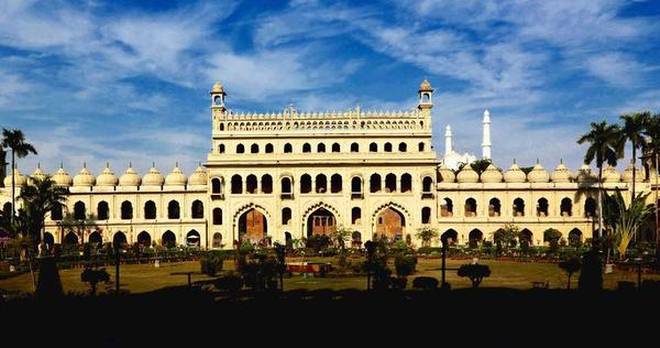Lucknow, UTTAR PRADESH / NEW DELHI :
In the Bara Imambara which was built to employ people struck by a famine in 1784
I grew up in Lucknow amidst magnificent Nawabi architecture, in the syncretic and gentle culture of Awadh. It was a way of life where others were given more importance over the self. “Pehle aap (you first)” was a commonly used phrase while speaking. It is always a pleasure to return to the city that is said have once been ruled by Lakshman; where excavations show a continuous settlement dating from the first millennium BCE through the early Gupta, medieval and modern periods.
In 1732, Mughal emperor Muhammad Shah appointed Saadat Khan Burhan-ul-Mulk as the governor of Awadh. With Faizabad as his capital, Burhan-ul-Mulk was first in the line of rulers, known as the Nawabs of Awadh, whose contribution to Indian culture and history is invaluable. Asaf-ud-Daula, the fourth Nawab of Awadh, shifted the capital from Faizabad to Lucknow, and from 1775 to 1856, Lucknow was built by the Nawabs as a unique architectural city with a syncretic culture.
Features of Nawabi architecture
The geography of Lucknow meant that stone and marble, the main features of Mughal architecture, had to give way to lakhauri brick-and-lime plaster buildings. The main features of Nawabi architecture were bulbous domes, vaulted halls, chhatris and double arches, with the inner one pointed and the outer one foliated, but the main improvisation given the resources and the unavailability of stone was the beautiful stucco ornamentation on buildings along with plaster decoration in the interior. The stucco work gave a deep relief even on flat walls, but unfortunately, much of it has been lost in repairs and whitewashing. The variety of motifs ranging from floral designs, false arches and false domes that produce an exceptional surface articulation of walls, columns and ceilings remain for us to marvel at.
Many stunning religious and secular buildings were constructed, but as the Nawabs were Shia, magnificent imambaras were their special contribution to architecture. An imambara is the place where congregational assemblies are held to commemorate the sacrifices of Imam Hussain, the grandson of Prophet Muhammad who was martyred along with friends and male members of his family in the Battle of Karbala by Yezid, the ruler of Syria.
Of these buildings, nothing is grander than the Bara Imambara, built as a relief measure for a populace stricken by famine in 1784. Construction continued till the famine ended. It was a hard time for all, including the elite. To ensure that they were not embarrassed to be seen working for daily wages, it is said that payment was made at night. This gave rise to the saying, “Jisse na de Maula, use de Asaf-ud-Daula (he who doesn’t receive from Allah is provided for by Asaf-ud-Daula)”.
Nawab Asaf-ud-daula (1775-1797 CE) chose Kifayatullah as the main architect. The place chosen had the hut of an old woman, Laso Saquum, in which she kept a small tazia, a replica of the shrine of Imam Hussain. She was reluctant to give her land but when Asaf-ud-daula promised to keep her tazia in the imambara, she gave the land for free. The tazia is kept there even today. The architect only asked for land for his burial as fees. He is buried, along with Asaf-ud-Daula, in the central hall of the imambara.
Inside the Imambara
One can enter it through one of the two three-arched gateways separated by a grassy forecourt. Once you enter the second gateway, the sheer size and magnificence of the Bara Imambara affects you. On the left is the exquisite seven-level Shahi Baoli (stepwell), initially dug as a well during construction. As it was a perennial source of water, it was built as a guesthouse later. On the right is the Asafi mosque on a raised plinth flanked by minarets with an impressive flight of steps. It faces Mecca.
The main hall with its vaulted roof is one of the largest of its kind in the world. It is unsupported: no column, pillars, wood or iron was used here. Its unique architectural design gave birth to the famous bhool bhulaiyya, which is above the hall and came about unintentionally to support the weight of the building. This is a labyrinth of more than 1,000 passageways and 489 identical doorways. It is among the few existing mazes in the world. Its acoustics are such that a match being struck on the other side of the hall can be heard. I like exploring it but always with a guide. After all, one must live to explore another day!
source: http://www.thehindu.com / The Hindu / Home> Opinion> Columns> Where Stones Speak / by Rana Safvi / October 28th, 2018









